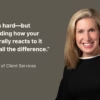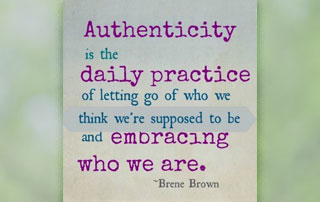Executive Presence: What Will Others See and Hear
By Chuck Mollor
Executive presence is the combination of being able to confidently command a room and interact with others, whether it be with one person, a team, or a broader audience. It’s the ability to stand and confidently lead a meeting, give a presentation or speech or have a successful interaction. Certain people can develop this presence more easily than others, but ultimately, it’s a skill that can be learned.
How you “come across” or present yourself and ideas, share information, ask questions, respond to challenges or attacks, develop people, work with teams, and communicate mission, vision, and purpose is your brand of executive presence. You don’t have to be an extrovert or assertive person. Quiet leaders have executive presence. Regardless of your style or approach, executive presence is a critical skill for great leaders.
Qualities of Executive Presence
People who have executive presence are consistently projecting the following qualities to their audience:
Candor: Honesty and transparency, through the willingness and skill to constructively tell it like it is.
Clarity: The ability to tell your story in an intuitive, clear, and compelling way.
Connection: It’s about connecting with your audience whether it’s one person or many. It’s about reading the room and being fully present. Not being distracted.
Openness: Not prejudging; being willing to consider another’s point of view.
Passion: The expression of commitment, motivation, and drive that shows people you believe in what you do, that you love what you do, and that you believe in others and what they do.
Poise: The look of control or balance; of pausing when you need to gather your thoughts; of not getting rattled when you are attacked, accused, or challenged.
Self-confidence: The air of assurance, such that others know you have strength and resolve, but not arrogance. To be humble with belief.
Sincerity: The conviction of believing in and meaning what you say, with empathy.
Thoughtfulness: Thinking something through or carefully considering something before responding.
Warmth: Caring about what the person has to say. Being accessible to others and being genuinely interested in them.
It is critical to note that these qualities have nothing to do with the content of the message. Instead, they have to do with how you position the content and tell your story. They’re about how you interact and engage with others. That’s because over 80% of most communication is non-verbal!
Your audience, whether it’s an audience of one or one thousand, is relying on things you do outside the content of your message to make important decisions about the message and you. Like most people, you probably don’t spend much time working on these non-content
factors. However, your audience spends most of its time evaluating them. This disconnect is why many people are perceived as not having much executive presence or even executive potential.
As an executive coach for over 20 years, I can share that there is not one style of presence that equates to success. Finding your voice is a personal journey and must be refined and mastered over time through experimentation, failure, and repeated execution. However, there are steps you can take to increase your success rate.
Steps to Increase Executive Presence
Developing the qualities of executive presence is easier for some people than others, but with some work, you can become highly effective.
Embrace your unique value. Do not go into meetings doubting your value. Prepare in advance; develop your unique perspective based on your individual, hard-won experiences, and developed expertise. Then walk in knowing you are an asset. Know that. Be humble and grateful to share your knowledge and experiences with others.
Be self-aware. Be aware of your body language. A killer pitch can be destroyed by lousy non-verbal communication. Stand upright and poised. Breathe slowly and regularly. Look people
in the eyes and genuinely engage. Be calm and purposeful with your gestures. All of this engenders trust. You look like you can handle anything—and you can.
Think before you speak. Many people ramble on, especially when excited or in the middle of a debate, without much thought for whether they make sense, are saying anything useful, or are being repetitive. Choose your words carefully. Think about your objectives. Don’t hurry to deliver the message. Take your time, be deliberate, pace yourself, and say much less than you think you need to. Ask questions, facilitate dialogue more, and offer fewer opinions.
Use the power of silence. Silence is an incredibly powerful tool and should never be underestimated. However, most of us feel awkward with silence and are compelled to fill it. When you pause, it shows you are in command of your thoughts, are not afraid to
reflect and slow down, and that you are not trying to rush through your topic or presentation. It also allows you to adjust what you want to say, or possibly even take on a new direction.
A well-chosen pause also allows the listener to digest your message. At the same time, you will enable yourself to assess your listeners’ behavior. When you do that, you can tailor your words and actions accordingly.
Engage with your audience. Persuasive communication is far more than what you are delivering. You need to relate to and engage with others. You need to make the audience feel like they matter to you. You do this by asking questions, gathering feedback, listening to what your audience says, reading their verbal and nonverbal cues, and discerning the appropriate response.
Know your material. Know what you are talking about when presenting, providing an opinion, making a suggestion, or engaging in a debate or disagreement. Hold your ground but be receptive and open to other views, listen to what others are saying and acknowledge their points of view. Be confident in your knowledge and expertise. Participate when you are in a discussion that isn’t your area of expertise and ask questions and follow up. Be comfortable with what you know and don’t know.
Utilize wit. Never forget your sense of humor. I’ve often heard leaders say they are afraid to use humor at the senior level in case they aren’t taken seriously. Yet this can backfire, as people who take themselves too seriously are ironically taken less seriously by their peers. A study by Bell Leadership Institute found that the two most desirable traits in leaders were a strong work ethic and a good sense of humor. At the same time, be careful about how you use humor.
Overly dry or sarcastic humor that cuts into someone or that few understand or appreciate isn’t effective.
Tell Your Story
As you will discover with the leadership journey, there is not one clear path. It takes time and experiences. Your story will evolve, especially as you learn how to share it in ways that resonate most with others. Ultimately, this skill will become a powerful part of your presence and your authentic and transparent self.
You can read more in Chuck Mollor’s best selling book, The Rise of the Agile Leader. Can You Make the Shift?
About MCG Partners
MCG Partners is a leadership and talent optimization firm– aligning your business and people strategy for maximum results. MCG Partners a woman-owned consultancy and is also a Predictive Index® (PI®) certified partner. To learn more please contact Stephanie Holmgren at [email protected] and at mcgpartners.com









